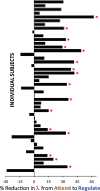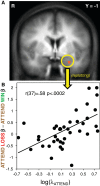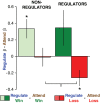Emotion regulation reduces loss aversion and decreases amygdala responses to losses
- PMID: 22275168
- PMCID: PMC3594725
- DOI: 10.1093/scan/nss002
Emotion regulation reduces loss aversion and decreases amygdala responses to losses
Abstract
Emotion regulation strategies can alter behavioral and physiological responses to emotional stimuli and the neural correlates of those responses in regions such as the amygdala or striatum. The current study investigates the brain systems engaged when using an emotion regulation technique during financial decisions. In decision making, regulating emotion with reappraisal-focused strategies that encourage taking a different perspective has been shown to reduce loss aversion as observed both in choices and in the relative arousal responses to actual loss and gain outcomes. In the current study, we find using fMRI that behavioral loss aversion correlates with amygdala activity in response to losses relative to gains. Success in regulating loss aversion also correlates with the reduction in amygdala responses to losses but not to gains. Furthermore, across both decisions and outcomes, we find the reappraisal strategy increases baseline activity in dorsolateral and ventromedial prefrontal cortex and the striatum. The similarity of the neural circuitry observed to that seen in emotion regulation, despite divergent tasks, serves as further evidence for a role of emotion in decision making, and for the power of reappraisal to change assessments of value and thereby choices.
Figures





References
-
- Amaral DB, Price JL, Pitkanen A, Carmichael ST. Anatomical organization of the primate amygdaloid complex. In: Aggleton JP, editor. The Amygdala: Neurobiological Aspects of Emotion, Memory, and Mental Dysfunction. New York: Wiley-Liss; 1992. pp. 1–66.
-
- Andrade EB, Ariely D. The enduring impact of transient emotions on decision making. Organizational Behavior And Human Decision Processes. 2009;109(1):1–8.
-
- Avnet T, Higgins ET. How regulatory fit affects value in consumer choices and opinions. Journal of Marketing Research. 2006;43(1):1–10.
-
- Badre D, D'Esposito M. Functional magnetic resonance imaging evidence for a hierarchical organization of the prefrontal cortex. Journal of Cognitive Neuroscience. 2007;19(12):2082–99. - PubMed

